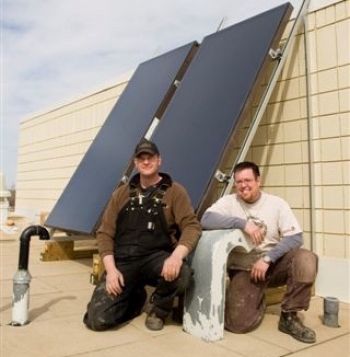Many people talk a good line when it comes to taking action on climate change. But this week Dawson Creek, a city of 12,000 people in northern B.C., has decided to put its money where its mouth is.
By contributing $100 to the city's newly created Carbon Fund for every tonne of greenhouse gas pollution the city produces from its own operations, Dawson Creek city council has made one of the strongest commitments of any Canadian community to tackle its contribution to climate change. We have had the pleasure of working with such a forward-looking community to help design and implement the fund in the most efficient and effective way possible.
The $100 per tonne charge will do three things:
1) The Carbon Fund will encourage Dawson Creek to invest in low-carbon projects that will lead to reduced emissions and smaller Carbon Fund contributions in the future — the more they reduce their emissions, the less they pay to the Carbon Fund;
2) The extra cost for each tonne of emissions will make energy efficient projects more cost-effective when avoided emissions (and therefore avoided payments into the Carbon Fund) are factored in; and
3) Every dollar that goes into the Carbon Fund will be used to pay for the same projects that help to reduce emissions. Projects like improving the energy efficiency of Dawson Creek's municipal vehicle fleet, or installing biomass heating or solar hot water systems on municipal facilities could all qualify for funding from the Carbon Fund.
D awson Creek is getting the best of both worlds: they're putting a price on pollution while making it more attractive to invest in the projects the community wants to see and are using the money collected into the Carbon Fund to help make those projects happen. Both of those pieces are important if Dawson Creek is going to fulfill its commitment under the B.C. Climate Action Charter to be carbon-neutral in its operations by 2012 — and with 179 communities in B.C. signed onto the Charter, Dawson Creek is taking a strong leadership position with its Carbon Fund.
awson Creek is getting the best of both worlds: they're putting a price on pollution while making it more attractive to invest in the projects the community wants to see and are using the money collected into the Carbon Fund to help make those projects happen. Both of those pieces are important if Dawson Creek is going to fulfill its commitment under the B.C. Climate Action Charter to be carbon-neutral in its operations by 2012 — and with 179 communities in B.C. signed onto the Charter, Dawson Creek is taking a strong leadership position with its Carbon Fund.
What does $100 per tonne mean for Dawson Creek?
In terms of making specific projects more or less attractive economically, it will depend on each project. As a general example, standard efficiency buildings may have a lower capital cost to build compared to a high-efficiency building. However, once built, the standard building would use more energy (and produce more greenhouse gas pollution) and therefore would have a higher energy bill and would result in a higher required contribution to the Carbon Fund. By accounting for the higher energy cost and higher required Carbon Fund contribution during project planning, Dawson Creek can start to make the economic case for implementing clean energy solutions.
Take a look at the numbers below for an example of how this might work. In this example, the price per tonne of carbon is $125 to account for both the $100 per tonne contribution to the Carbon Fund, and the approximate $25 cost of offsetting any new emissions from the project (Dawson Creek is still committed to purchasing high quality offsets to meet its Carbon Neutral commitment).
|
|
Building A |
Building B |
||
| Efficiency rating |
|
|
||
|
Capital cost ($) |
$4,000,000 |
$4,320,000 |
||
|
Building lifespan (years) |
35 |
35 |
||
|
Operating cost ($ per year) |
$50,000 |
$35,000 |
||
|
Estimated emissions (tonnes C02e per year) |
125 |
87.5 |
||
|
Cost of anticipated emissions ($125 per year) |
$15,625 |
$10,938 |
||
|
Total |
$5,023,909 |
$4,978,275 |
By accounting for the cost of energy, offsets and the Carbon Fund contribution, Dawson Creek can demonstrate that the high efficiency building would be cheaper to build and operate over the lifetime of the building.
In terms of the anticipated annual investment enabled by the Carbon Fund, Dawson Creek's corporate greenhouse gas emissions were approximately 3,600 tonnes in 2010 — so their initial investment in the carbon fund will be about $360,000. As projects made possible by the Carbon Fund help to reduce emissions in Dawson Creek, they will in turn reduce the required $100 per tonne investment in subsequent years. Conversely, if Dawson Creek's emissions rise in 2011, their investment in the Carbon Fund will also rise.
Many experts agree that putting a price on carbon, as Dawson Creek has done, is an essential tool in our fight against climate change. Just like British Columbia's carbon tax is a positive example for provincial and federal governments of how carbon pricing can work, Dawson Creek's Carbon Fund sets a new benchmark for communities across the country that are committed to reducing greenhouse gas pollution and supporting low-carbon energy use.
We look forward to seeing what new projects the Carbon Fund will enable and we hope that other B.C. communities will follow in Dawson Creek's footsteps.






